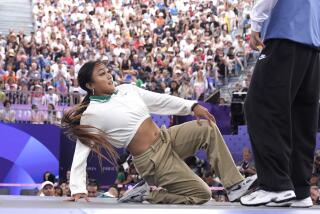No Color Lines
There weren’t any big celebrations or much attention on Jan. 18, 1958, when Willie O’Ree made his NHL debut as a winger for the Boston Bruins.
But 44 years later, people still talk about the night he broke the NHL color line.
“I’m getting more coverage now because everywhere you look, there’s a story about all of the players of color coming into the league,” said O’Ree, who is in Los Angeles this week conducting hockey clinics for inner-city boys and girls leading up to Saturday’s All-Star game at Staples Center. “When that happens, they end up talking about Willie O’Ree breaking the color barrier.”
For years, O’Ree’s name was mainly remembered as an answer for a hockey trivia quiz but not much else. There are many sports fans who think hockey is still played only by whitesBut the number of black players in the league has grown to a record 15 this season, including Calgary’s Jarome Iginla, who leads the NHL--with more than 700 players--in goals scored.
While league officials and others acknowledge that more can be done to expand the NHL’s recruiting pool, O’Ree wants to take a moment to savor the progress already made.
“I feel really wonderful,” said O’Ree, who became the NHL’s Director of Youth Development and Diversity Task Force four years ago to find ways to expose inner-city youths to hockey. “I’m happy that I was in a position to break down barriers and open doors for these players of color to play now.”
In the first half of the 20th century, black players were fully integrated in Canadian hockey. But as the NHL grew to prominence from a loosely organized six league team, the league’s two Canadian franchises adopted the U.S.’s active policy of exclusion and began to shun black players.
Many black players chose to stay in Canada, however, and play for other professional leagues, where the pay and the level of competition were comparable to the NHL.
It wasn’t until 1958 that O’Ree became the NHL’s first black player, an especially notable achievement because O’Ree had been legally blinded in one eye years earlier, after being struck in the face by a puck.
He said his teammates welcomed him.
“I felt as I belonged, because the Boston Bruins organization was very supportive, and made me feel a part of the team,” he said.
It took another 15 years until a second black player, Mike Marson, joined the Capitals. All told, it has taken nearly 75 years for blacks to gain a foothold into the NHL
No one can say for sure, but racism is believed to have played a role in the time gap between the two players. And O’Ree believes that it also cost Stan Maxwell, a former teammate and close friend, his chance to play in the NHL.
“We turned pro together in 1956 with the Quebec Aces and went to the Bruins’ training camp together,” O’Ree said about Maxwell. “I got the call in 1958, but Stan could have gotten the call just as easy. He could skate, shoot, pass ... he had all the equipment. They just didn’t call on him. He was really good.”
After two seasons with the Bruins and only four goals, O’Ree went to the minor-league Los Angeles Blades.
“I was just fortunate enough to reach the NHL, I wish I could have played longer,” said O’Ree.
Now players such as Edmonton’s Anson Carter, whose dreadlocks make him difficult to overlook, can just play hockey and not worry about race.
“When I look outside, I don’t see myself as a black hockey player, I see myself as a hockey player,” Carter said. “When I’m behind my eyes, and looking out to see the world, I don’t think ‘I’m a black hockey player.’ I know I am, but that’s not how I see things. I have a job I have to do.”
Getting the job done is something black players are doing well this season.
Iginla, whose father is a Nigerian native, has led the league in scoring for most of the season and his play earned him a spot on the Canadian Olympic team.
Carter leads the Oilers in scoring and goals scored. St. Louis goaltender Fred Brathwaite has the third best goals-against-average in the league and Tampa Bay goalie Kevin Weekes has one of the NHL’s top save percentages.
And then there is Edmonton’s Georges Laraque, Philadelphia’s Donald Brashear and Florida’s Peter Worrell, who are not only three of the best fighters in the league but also key contributors to their respective teams.
Like a proud father, O’Ree looks at today’s black players with admiration.
“I knew that players of color would someday have a bigger role in hockey but I didn’t expect to see as many coming into the league at one time,” said O’Ree, who grew up the youngest of 12 children in New Brunswick, Canada. “Look at Edmonton. [The Oilers] have four black players on the team.”
For many of today’s black players, former NHL goaltender Grant Fuhr, who won five Stanley Cup championships with Edmonton, was the player they watched while growing up.
Although Fuhr didn’t get mainstream attention for being a black player in the NHL--probably because he wore a mask during games--that didn’t discourage Iginla, who grew up in Edmonton.
“It was nice to see a black player not just playing, but starring in the NHL,” Iginla said earlier this season.
O’Ree said he has enjoyed following the development of players such as Iginla and Carter and believes the best is yet to come for blacks in the NHL.
“Everybody says that I think we need a person of color to be the next Wayne Gretzky, I don’t agree with that,” O’Ree said. “I think we need more players of color coming into the league and there will be a Wayne Gretzky. Maybe not next year or five years from now, but eventually it would happen.
“The guys in the league now are good hockey players. They have talent and skill. They are there because they are good and not because they are black.”
Although O’Ree played in only 45 NHL games, there are some people who believe that he should be in the Hockey Hall of Fame.
But don’t count on him to push for the honor.
“If it happens, it happens,” O’Ree said. “I am not going to lose any sleep over it. I’m going to continue what I’m doing because I enjoy what I am doing.”
Besides breaking the color barrier, he said, the “the greatest thing that has happened to me” is having the change to introduce hockey to young girls and boys.
And watch his legend grow each time another player of color reaches the NHL.
*
Staff Writer Roy Jurgens contributed to this report.
*
(BEGIN TEXT OF INFOBOX)
Black Players in the NHL
(text of infobox not included)
More to Read
Go beyond the scoreboard
Get the latest on L.A.'s teams in the daily Sports Report newsletter.
You may occasionally receive promotional content from the Los Angeles Times.






